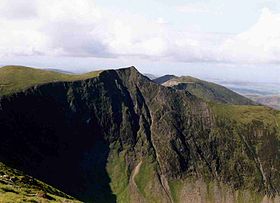Hopegill Head
| Hopegill Head | |
|---|---|

Hobcarton Crag is beneath the fell. The grassy hill on the left is Sand Hill. |
|
| Highest point | |
| Elevation | 770 m (2,530 ft) |
| Prominence | 97 m (318 ft) |
| Parent peak | Grisedale Pike |
| Listing | Wainwright, Hewitt, Nuttall |
| Coordinates | 54°35′15″N 3°15′46″W / 54.5875°N 3.26267°WCoordinates: 54°35′15″N 3°15′46″W / 54.5875°N 3.26267°W |
| Naming | |
| Translation | Source of Hope Gill |
| Geography | |
| Location | Cumbria, England |
| Parent range | Lake District, North Western Fells |
| OS grid | NY185221 |
| Topo map | OS Landranger 89, 90, OS Explorer Outdoor Leisure 4 |
| Listed summits of Hopegill Head | ||||
| Name | Grid ref | Height | Status | |
|---|---|---|---|---|
| Sand Hill | NY187218 | 756 m (2,480 ft) | Nuttall | |
| Ladyside Pike | NY185227 | 703 m (2,306 ft) | Nuttall | |
Hopegill Head is a fell in the English Lake District in Cumbria. It is located nine kilometres (5½ miles) west of the town of Keswick and is well seen from the B5292 road which crosses the Whinlatter Pass.
Hopegill Head is the middle fell of three fells on a ridge that starts at Braithwaite and goes west for eight kilometres to conclude at the northern end of Crummock Water. The other two fells on the ridge are Grisedale Pike and Whiteside. The fell is often referred to locally as Hobcarton Pike as it stands at the head of Hobcarton Gill. However, the Ordnance Survey have officially named the fell Hopegill Head on maps after Hope Gill, which is another valley that goes north-west from the summit. Hopegill Head reaches a height of 770 metres (2526 feet) and has two subsidiary summits, Ladyside Pike (703 metres / 2306 feet) and Sand Hill (756 metres / 2480 feet) both of which have Nuttall status.
Hopegill Head’s most striking feature is the 130-metre-high (417-foot-high) cliff of Hobcarton Crag, which drops precipitously to Hobcarton Gill on the fell's north east side. These cliffs are unsuitable for conventional rock climbing because they are made of crumbly Skiddaw Slate but they do provide good winter climbing with the best known routes being Thompson’s Chimney and Cave Route. The crags, which are owned by the National Trust, are the only location in England of Viscaria alpina, the red alpine catchfly.
The laminated mudstone and siltstone of the Kirkstile Formation predominated, with the underlyng greywacke sandstone of the Loweswater Formation outcropping to the north.
...
Wikipedia

